D'Addario XL (and EXL) Strings - Time Proven Favorites
This is an opinion review, not a religious or fan-boy review... This is an experienced view of a high-quality brand and string... I play MANY brands of strings, including D'Addario XLs - I believe my review presentation is objective...
As a musician, a guitar nut, and a recording artist, I'm always exploring different things to get different sounds. I'm always trying out strings, picks, pickups, electronics, and much more... always looking to see what something sounds like or feels like.
Strings are a fundamental of music with stringed instruments. Just as a stylus is important to the audio output quality of a fine phonograph, strings effect the sound quality of an instrument. Also, the
feel of strings is important to the way the musician interacts with their instrument. There are many, many things about strings that are very personal in nature...
So, what do we feel about our strings? It seems as though every musician with whom I speak has a completely different view of their strings. It's truly amazing. Musicians, from pro to novice, all express divergent views on their strings.
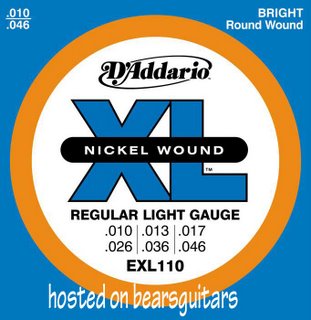
Some folks are so fanatic about their strings that they will spend long periods of time going through identical sets of strings to get just the perfect string or set or pairs or sets of strings. Yet there are others who have the attitude of "it doesn't matter to me, just make sure they're nickel-plated 10s" or "I guess I should change my strings - they're a year old now."
And yet others are somewhere in between. What's right? The right answer is, if the strings do what you want, then they're the right ones.
So, enough about the philosophy of strings... let's talk about a particular brand and type... I'll write more reviews about other brands and types down the road a bit. Today, I'm going to ramble about D'Addario XL strings.
Read more and get pricing information here at GuitarCenter.com
Briefly: I don't beat my strings, nor do I pick/pluck extremely hard or firmly. But, on the other hand, I don't have the light touch, either. Suffice it to say that I am somewhere in the middle when it comes to being hard on my strings. Also, I do like fresh strings - both from a cleanliness point of view and from a sound point of view. I change my strings when they feel icky or they begin to "darken" my instrument's sound. I don't like blackened rough strings or strings that are smelly and dull-sounding... with that in mind, let's do some exploration...
Quality:
First of all, I love these. They're super-consistent quality. I've opened, installed, and played hundreds of sets of D'Addario XL guitar and bass strings - and I've NEVER had one with a bend, a "funny place", or with a largely unreliable sound.
D'Addario strings, in general, are extremely consistent and extremely reliable. I've never had one break. I've never had one "go dull" on me before the rest of the set. I've never had one feel strange when I'm playing. The quality is good and consistent.
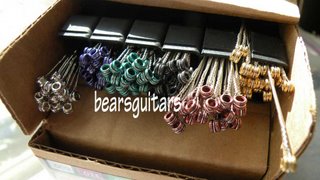 Sound:
Sound:
Here's one of the main things about strings... how do they sound? Not all strings are the same manufacture, not all strings sound the same, and not all strings are musical in the same way.
D'Addario XLs sound generally bright, whether you're playing nickel-plate, pure nickel, or acoustic brass/bronze strings. They have a nice growl to them that sounds like freshly wound metal - very nice. I've played strings from other manufacturers - strings bearing virtually the exact same specs as the XLs I've played. In general, the D'Addarios growl a little more, sing a little more, and produce a mellow tone when played easy on clean.
Value:
D'Addario XLs are generally priced within a half-dollar of all of its competitors. I don't feel that D'Addario XLs are expensive or cheap - they seem priced just right... I feel as though they are the "workhorse" type of string - a brand and type musicians can count on.
They're a great value and will please a large percentage of the string-instrument-playing population...
Long Lasting:
D'Addario XLs last a fairly long time. There are other brands and types I've used that stay close to "fresh" feel and sound longer than the XLs I play, but not many. I have also played brands (brands that I DO like, mind you) that don't last nearly as long.
In general, D'Addario XLs seem to last well past average, and are consistently in the top range of long-lasting uncoated strings.
Closing opinion:
I love D'Addarios. I install them on customer's guitars very frequently. I have a couple of guitars that get nothing but D'Addario XLs (generally 10s). I REALLY like the phosphor-bronze sets I use on my Ibanez acoustic.
I love the quality and the general sound of them. I like the multi-pack options to save some coin, and I like the way they feel even up to the time when they start to get grimy.
They're great strings. Give them a try.
Labels: acoustic guitar, bass guitar, Bass Strings, D'Addario, electric guitar, great sounding, Guitar Strings, high quality, long lasting, strings, XL110, Xl120
Washburn Rover Acoustic Travel Guitar Review
My family and I went to Montana for a week's vacation out in the beautiful mountains of the Grand Tetons and Jackson hole. Thing is, my son and I went through
serious guitar withdrawals. We even went to a little local pawn shop to look for something cheap to buy... No luck there... We learned our lesson about traveling without our six-stringed friends...
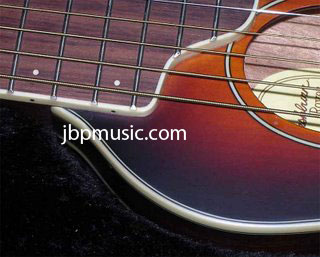
I did a lot of research, playing thinking, and reading. Mrs. Bear said that it would be cool if I went out and found a travel guitar for a treat - to be sure her boys didn't go through withdrawals on later trips. Among the many entries in the travel guitar world, I chose the Washburn Rover. Here's why:
Quick Opinion: The Washburn Rover is a good bargain that has lots of nice features, decent build quality, and great playability. I absolutely enjoy playing my Rover - for more than two years now...
Before you read on, let me explain something very important: A travel guitar is not a warm and brassy hand-made high-end guitar. Travel guitars (all of them) aren't right for recording your next piece for a Pixar film or for playing in a back band for James Taylor or Randy Travis (big fan of both!). A travel guitar is made to feed your playing jones while you're on the road and don't want to tote your Gibson Songwriter around in a jet-powered puddle-jumping tuna can...
You can read about other/competitive travel guitars here at GuitarCenter.com
The Washburn Rover is an excellent all-around choice. It plays great (for something so small) and sounds reasonable enough to make you smile when you sit on the porch, look at the mountains, and play your tunes... Kick back and enjoy your Rover... It has brought music to many adventures. It looks and feels like a nice full-size neck with a little curvy body on the end...
Features: The Washburn Rover is chock full of features for such an inexpensive guitar in such a small size. Let me list out a few for you:
Fully bound body and neck;
Solid (!) spruce top;
Mahogany neck, back, and sides;
An actual, fully-useable 24" scale;
Reasonable build quality;
Reasonably well-dressed and set frets;
Compact enough that it fits in many (probably not all, these days) airline overhead bins - I've done this plenty (and the neighboring passengers can still cram their entire household-in-one-overstuffed-bag bag next to it or under it);
and Simple old-fashioned butterbean open tuners.
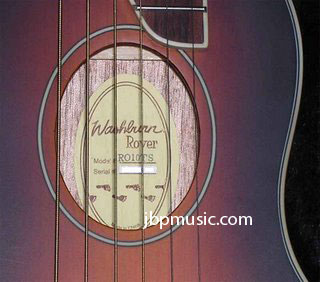
Feature-wise, the Rover is rich. It comes with a strap and an allen wrench. It even comes with an excellent lightweight zippered fabric-on-foam case that is very sturdy and very lightweight. I've carried mine TONS of places and have never felt bothered by carrying around our Rover (we named it "Rover" - surprised?). It is by far the best bargain for the money, given the features alone.
Quality: The quality of my particular Rover is excellent. It rivals most basic acoustic guitars, and even a few middling ones. It isn't the perfect detail of a Yamaha student guitar, but it is very close. Overall, you will probably find a few flaws in the finish, or a bumple or two in the binding.
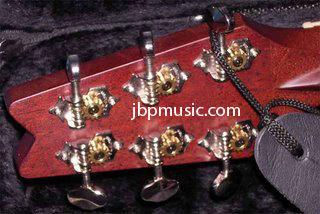
However, the neck is straight and comfortable, the finish feels really quite good on the skin, the neck is finished very well, and the tuners are actually quite nice. Overall, the build quality exceeds many $300 guitars. Perfect? No. Excellent for its cost? Absolutely.
The tuners are the exposed-gear variety. They're not sealed 18:1 Grovers or super-cool Klusons. They're basic. However, they stay very close to being in tune the entire time I'm playing on the porch. That's good enough for me. From an intonation perspective, the Rover is very close to being a near-tempered in-tune instrument. Sometimes you have to sacrifice between tuning for a nice clean D Major chord and a clean warm C Major chord. Using a sweetened tuner like the Peterson StroboSoft or Strobing hardware tuner makes things sound better.
Playability: From the perspective of action, neck feel, and string spacing, the guitar plays awesome - just like a champ. Close your eyes and your fretting hand won't know it is holding a little travel guitar. The action is as smooth as butter (I like 11s in some sort of bronze, usually Ernie Ball Earthwoods of some sort or Martin phosphor bronzes.) It really plays much easier than my larger guitars.
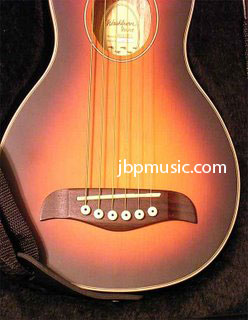
The downside? With any tiny-body guitar (not just the Rover, but all of them), you can't sit it on your leg and relax sitting down with it. If you want to be comfortable and not have to clamp the guitar to your chest, install the included canvas strap. Once the strap is on and around your neck, the guitar actually plays pretty effortlessly. If you don't wear the strap, you'll find yourself fiddling with it all the time (no pun intended, or, maybe pun intended?).
Sound: I've played several travel acoustic guitars. Plug-in electric-earbud guitars, very inexpensive no-name imports, and some from the very big brand names. I love the Martin, truly... but the Rover is warmer and less tinny sounding. Even though I'm a huge Martin and Taylor fan, the little Washburn won my ears over immediately.
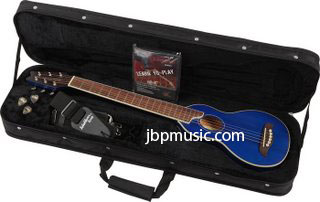
So, what does it sound like? It sounds like a really nice guitar that is played back through an inexpensive stereo with little bitty speakers. It is fun, not too hard on the ears, and actually has an admirable flavor and character. Bear this in mind: none of them sound big, boomy, warm, and growly. The Washburn Rover is definitely the best of them (in the low-cost range). The Rover actually is more warm (with 92/8 phosphor bronze strings) than some of the expensive boutique travel guitars. The strings REALLY make a difference. Don't cheap out on the strings. Just don't expect it to sound like my Big Baby Taylor or my cedar-top Tak.
Value: The value exceeds its current $149 price. It is less expensive than its cousins and even comes with a good case. It is definitely worth much more. It is a high-value, very fun-to-play instrument.
Wishes: Washburn already answered my one wish for this: They now come in neat transparent colors and a new natural color. (Bear in mind, I haven't seen any of the sunburst-brown ones like our Rover in recent months.)
Labels: acoustic guitar, fun, guitar, review, rover, travel, vacation, washburn, washburn rover
Taylor Big Baby Taylor Acoustic Guitar Review
Birthday presents are fun sometimes. Last year, a local fellow sold me his one-year-old Big Baby Taylor for a song. I was thrilled. I've
always wanted a Taylor acoustic, American made, spruce top, and more. I got my wish last October.
I was looking for a moderately bright guitar sound, but one that was also warm enough for making recordings/serenading my family... I like the darker sound of my cedar-top dreadnaught, but I needed a complimentary, tenor-/alto-voiced sound. Clean, crisp, defined.
The Big Baby Taylor fits the bill, and then some... Here's why I love mine...
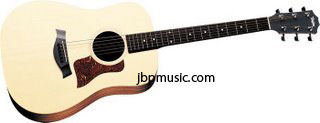 Quick Opinion:
Quick Opinion: The Big Baby Taylor is light, resonant, durable, and very simple. It's comfortable to hold for hours and has a finish that is very easy on the skin. I love this guitar. Where else can you get American-made quality, solid spruce top, ebony fretboard, and nice voicing for so little?
It only took me a couple of minutes to adjust to playing the BBT for the first time at my local guitar store. It was like playing an old favorite guitar, right from the start. I was surprised at its light weight, and more interestingly, its decent sound projection.
You can get more info and pricing information about Big Baby Taylor acoustics (they make a NICE lefty too!) here at GuitarCenter.com
Buy a Big Baby Taylor. They're great instruments all around...
Features: The Big Baby Taylor is fairly basic and simple (a good thing), yet has attributes that make it an outstanding choice for someone who wants nice sound on a moderate budget.
The neck is a nice mahogany wood, with a satin finish and a moderate profile. This one isn't thin like a Strat or a Jackson, nor is the neck a log like the big-necked resonators or 50s electric guitars. The profile is comfortable for most sizes of hands. The neck is actually bolted on with screws going through the fretboard into the body. The screws are completely unobtrusive and do not come into mind when playing the BBT. The benefit of this type of neck is that it can be adjusted without popping the neck out of its glue in its pocket, as you would with a set-neck acoustic.
The ebony fretboard is a very nice touch. It is comfortable, doesn't leave your fingers black with wood dye, and is durable. It looks good, too. The satin black headstock face blends down nicely into the fretboard's color.
The body is non-bound, but has decent edge joints. The rosette is etched around the sound hole. The top is solid Sitka spruce, and the back and sides are laminate. Overall, for a sub-$500 guitar, the body is excellent. The satin finish is very nice and very evenly applied.
Quality: The quality of my Big Baby Taylor is great. All the edges where the top and back meet the sides are clean and smooth. Only once (where the edge was whacked against a corner of something in its previous life) have I found a place where the joint felt a little off... which is to say, no problems at all.
The neck and frets are extremely nicely done, the frets are end-crowned for comfort for your paws, The neck finish isn't too slick or too grabby, it is nice and satin-y. My Taylor's neck is two-piece. There is a joint at the end of the headstock/neck merge. The joint is exceptionally strong and smooth to the touch.
The tuning machines are fine quality and have a decent smoothness. I've not had any troubles keeping my Taylor in tune - even after hours of playing (and even in and out of the case a few times). I found some ebony tuning machine knobs and replaced the factory chrome ones - the look is truly awesome.
The back is a little grainy for my tastes... but it doesn't effect sound or comfort in any way. The nut and saddle bridge appear to be either something like Tusq or some other not-cheap-plastic material. I don't get "pings" when tuning the strings or bending strings while playing.
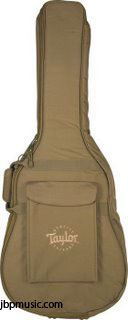 Playability:
Playability: Plays like a charm. Lightweight, nice neck, comfortable body finish, medium-low action (maybe even low-action). I can pluck fairly hard before I get any buzzes. I don't usually dig in to my guitars with a thick pick much (I'm a hybrid pick-and-fingers guy), but it took an effort to whack the sound.
The size of the guitar (15/16) is unnoticeable - it is a dreadnaught, and feels only slightly smaller than my big Tak dread...
The Big Baby Taylor is significantly easier to play than nearly every acoustic I've played in the sub $500 range. It's a real treat - simple, no fuss - I can concentrate on my music. I have no negatives to say about this guitar in the playability department.
Sound: The Big Baby Taylor is surprisingly loud for a 1/5/16 guitar. It has a tone that is a nice mix between warm and bright - depending where you play on the neck/strings and how you play. You can coax very subtle sounds and great volume dynamics from this guitar.
I put phosphor-bronze strings on my Taylor (Ernie's Hybrid Slinky Acoustics, to be exact). I found that the phosphor-bronze strings really brought out texture and character in this guitar. With straight 80/20 brass-wrapped strings, the low strings seemed a bit thin to my ears. My Ernies really made this guitar sing...
I also added brass string-pins to my BBT. I don't know that they really made the sound too much different, but the combination of the phosphor-bronze strings and the brass pins makes the guitar a dream and a treat for the ears.
Value: The Big Baby Taylor is easily a better bargain than many $500-$600 guitars from a variety of manufacturers. It is sort of a "sleeper", one of the best-kept secrets of the acoustic guitar world. It has big value in a medium price. Mine came with a very nicely padded gig bag (much better than most, much!). It's hard to find an American-made guitar (acoustic or electric) in this price range at all, much less one that is a realy pleasure to play.
Wishes: My only wish? A one-piece neck, or at least one that is one-piece from the body to the end of the headstock.
Labels: acoustic guitar, big baby taylor, dreadnaught, guitar, made in USA, review, taylor
Peterson Tuners StroboSoft Tuning Software Review
I record many different types of music via my computer. I use guitars, basses, keyboards, and mic-recorded vocals and acoustic sounds/instruments. I am constantly in need of a tuner which keeps me from having to worry about intonation issues.
Guitars (the whole family, basses, 6-strings, 7-strings, exotics) and just about every stringed instrument are not
well-tempered.
Read about instrument tempering here. It's fascinating - opens new window. Sometimes, just tuning your instrument to the exact correct chromatic pitches isn't going to give you better sound - "in tune", yes, better sound, no. I've fought the tunings of my guitars for ages (particularly acoustics). Tune up to the correct notes, play three different tracks together with the exact same instrument and the exact same tuning - sometimes the three tracks played together don't sound too good. Why? Tempering. Lack of sweetening.
If you want to tune to the exact pitches your instrument plays, then the StroboSoft sofware (and Peterson's peerless hardware tuners) will give you just what you want, down to the cent (a cent is effectively a hundredth of a tone). But, some technologies help you by giving you "sweetened tunings" - these tunings include the famous and wonderful Buzz Felten tuning system sweetening settings. There are other excellent tunings available to warm and broaden your harmonic and melodic sounds. With StroboSoft, you can spend your time with your music, not with fiddling with your tuner for hours on end.
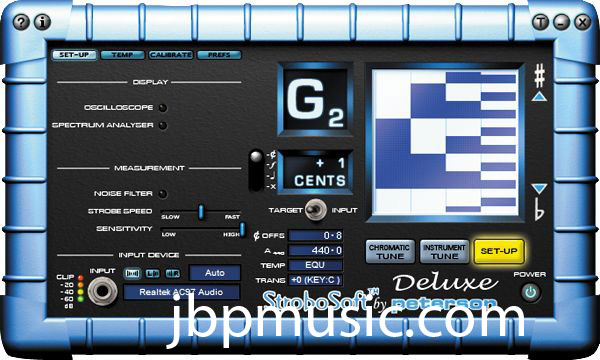
Peterson's hardware strobe tuners are the best of the best of the best. I've been interacting with them since I was in school band back in the seventies. Recent Peterson Tuners for guitar, bass and other stringed instruments include sweetened tunings. StroboSoft Deluxe also includes sweetened tunings - all of which work
WONDERS for your music and your ears!
Free Shipping and more information for Peterson StroboSoft
If you'd like to read more about StroboSoft in detail, you can visit the StroboSoft site here:
StroboSoft.
Quick Opinion: Buy this piece of software. Buy this piece of software. Buy this piece of software. Really: Buy this piece of software. Your music will sound better, your music will flow better, you'll have more time to work on your music...
If you're gigging, playing outside a studio, or on the road - invest in a hardware Peterson Tuner (and take StroboSoft's capability with you). The hardware tuners are more expensive than the average hardware tuner, but they are worth it. At some point, I'm going to save up enough sheckels and buy a StroboStomp or the rack version for myself... Their hardware is well worth twice (or more) than their current street prices.
If I can get my paws on a Peterson hardware tuner in the near future, I will write an extensive review of it, as well.
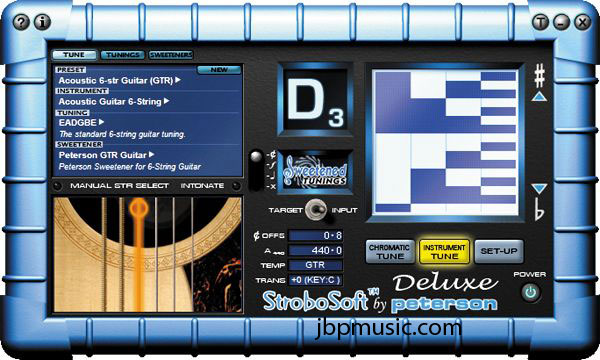 Features:
Features: StroboSoft is a snap to use. Install it, go to the setup tab, select your instrument input hardward device, click on "Instrument tune", then choose what kind of tuning you want (6 String electric? 6 String Acoustic? Sweetened? 5 String Bass?). Pluck your strings, and work your tuners/slides/instrument tuning device until the strobe stops moving up or down. You're done.
Set up for the first time takes very little time. Just take a few minutes to read their introduction, set it up, and GO. YOUR music will be sweeter, warmer, and more natural-sounding in a few minutes. Be sure to check out and set up the noise canceling feature (so it can tune easier, even on a noisy guitar or mic) - once you're up and running and understand what the tuner's doing.
Quality: I have had no issues whatsoever with StroboSoft on any of the three computers I use for recording. It has never crashed, misbehaved, or given me the first issue. Flawless.
In case you're wondering, this review is glowing because the product
REALLY deserves it - not because of any other factor.
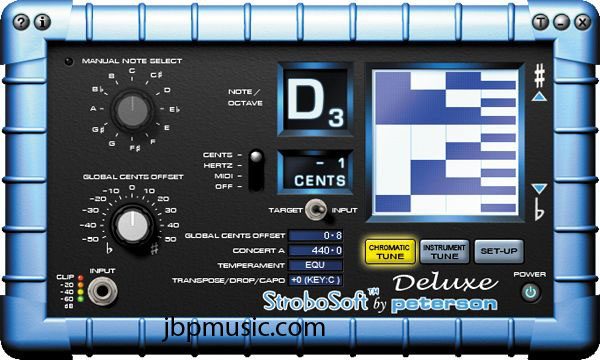 Value:
Value: In my opinion, this software is worth at least as much as Peterson Tuners' StroboFlip and StroboStomp hardware. I'm very impressed (and, frankly very, very happy) that it costs so little. The forums get answered, the emails get answered, the folks at Peterson care about their customers, and you cannot find a better value on the market.
Period.
Wishes: I'd love to see a Mac OSX dashboard widget interface to StroboSoft... just a thought...
Labels: 4 string bass, acoustic bass, acoustic guitar, computer recording, electric guitar, jimmy pearson, macintosh, osx, peterson, software, strobosoft, tuner, tuning, violin, vista, windows, xp
Jimmie Vaughan Fender Stratocaster Longer-Term Review and Impressions
My previous review of my Jimmie Vaughan Fender Stratocaster has had hundreds of reads and lots of positive reactions and emails. Thank you all for reading! I've been playing my Jimmie Vaughan for a couple of years now... it's still a seriously wonderful instrument, and is a pleasure to play. I've had other Stratocasters now and then since I purchased my Jimmie Vaughan, but none give me the vibe and feel that Jimmie does. (Most folks call these Strats the
Jimmy Vaughan Strat...)
I'm going to deviate a bit from my standard review format for this particular write-up. The Jimmie Vaughan Fender Strat is an extraordinary instrument, and has been an extraordinarily good influence on me and my music. I have used my Jimmie Vaughan on three albums now (soon to be a fourth). It is indispensable and an absolute joy to play. Imagine an instrument with an old warm soul – warm and complete – even though it is only a couple of years old. That old soul is harnessed in the Jimmie Vaughn signature Fender Strat.
What follows is my (humble) opinion about this fine instrument – based on real-time experience and hundreds of hours of play. I've made sounds from six different genres with my JV Strat...
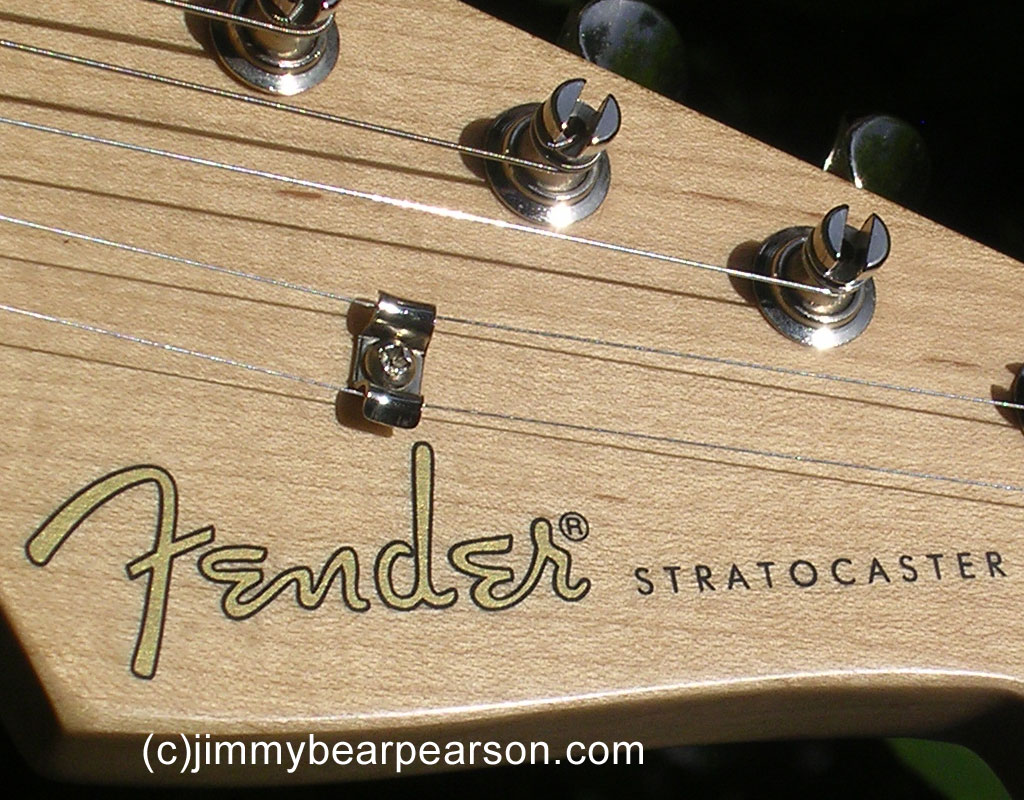 Free Shipping and more information about the wonderful Jimmie Vaughan Fender Stratocaster here at GuitarCenter.com
Free Shipping and more information about the wonderful Jimmie Vaughan Fender Stratocaster here at GuitarCenter.com Playability:
Playability: When one picks up a JV Strat, something sparkles in one's imagination and in one's consciousness. It is light-weight, extremely well-balanced, and has a great mixture of features and parts. I want to be very clear that I am not gushing praise on this instrument due to a relationship with a vendor, manufacturer, or for any other reason – I've played this instrument a great deal, and I look forward to each opportunity to play my JV Strat.
The neck is still one of the best features of the instrument. It is a nicely-graduated V profile, with great wood, a great carve, and great finishing. The neck has a nice tint, and its finish is a wonderful balance between satin and gloss. When my hands sweat from playing in a hot room, the finish on the neck does not feel grabby or overly slippery. I wish all my Strats had this same neck and neck finish. The fretboard width at the nut and at the saddles is just right – I can finger-pick, hybrid pick, chicken-pick, strum, and more – all in complete comfort for both my hands.
The body contour, weight, and balance is about as comfortable and playable as any guitar I've ever had the pleasure to play. Even the consistent, smooth, and beautiful finish of the paint on the body makes the guitar more playable - it's like holding a brand new guitar, even after a couple of years of wear.
 Features:
Features: One of the strengths of the JV Strat is its diversity of features. It has a great, upscale neck. It has awesome wiring. It has great-sounding pickups. It has wonderful vintage-style tuners (with old-style string-in-post machine heads).
All these features, plus a vintage-looking pick guard and an awesome vintage-style tremolo/whammy make for a Stratocaster package you'll enjoy for years to come. Other than some funky knobs, I've left my JV Strat completely stock – and it will stay that way: it's just right, just like it is.
Sound: Playability and sound are the JV Strat's strongest suits. By far, the wiring and Tex-Mex special pickups in the JV Strat sound distinctive, strong and vintage at the same time, with dynamic sound diversity to spare.
The JV Strat can play along with country, rock (any), jazzy warm music, smooth music, and even hard rock music. A flip of the pickup selector and a change of gain/eq cause the JV Strat to seem like tons of different guitars. The Jimmie Vaughan Stratocaster is versatile enough to even please my son (he prefers hard-rockin' nads-to-the-wall double-humbuckin' guitars). I asked him one day which Fender he'd like to get his hands on (if I were to ever let any of them out of my cold, stiff hands ;-)). Without hesitation, he said, "I have always wanted to keep Jimmie.” 'Nuff said!
Value: The Jimmie Vaughan signature Fender Stratocaster is not the least-expensive Strat in Fender's stable. It is, however, very high in value as compared to other non-USA Stratocasters. With a JV Strat, you get good build quality, great electronics, a superior neck, and good finish in one nice package. I still think it is very much worth its street price. Looking back over the past couple of years, I would definitely say that I would buy it all over again, only to find joy in guitar playing again.
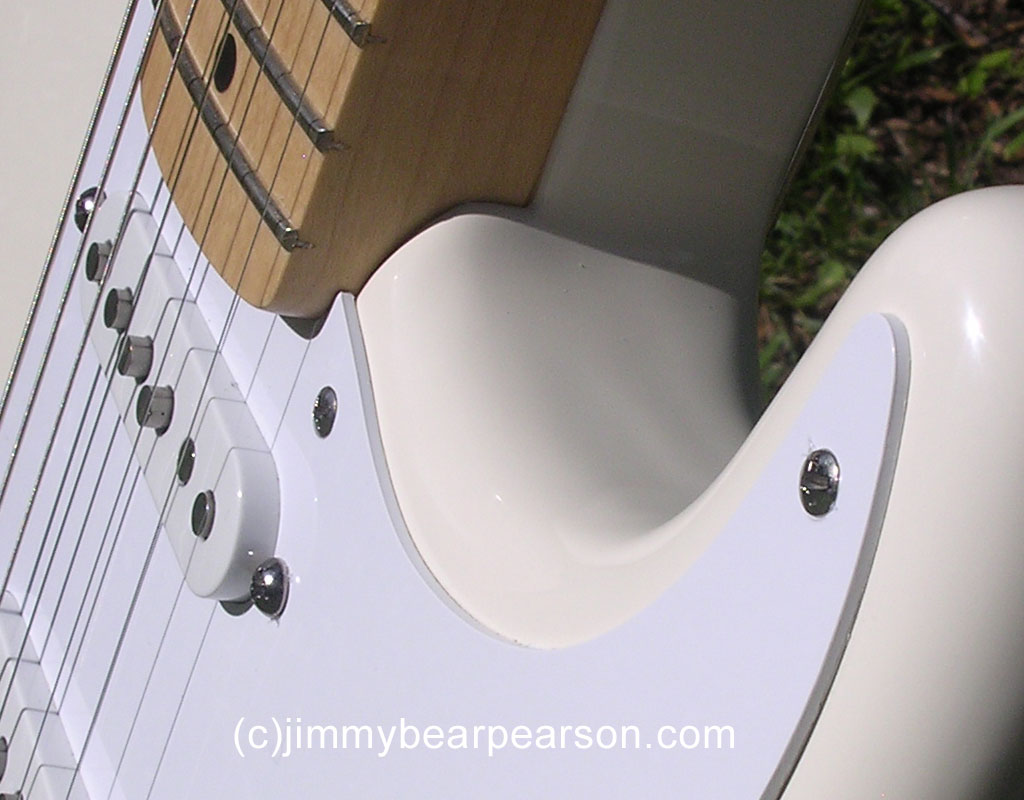 Wishes:
Wishes: I have come to love the simple, vintage-look pick guard. I have no wishes to change this guitar. I wouldn't change a thing – except that I wish I had a second Jimmie Vaughan Strat to play – I don't want these to go off the market before I get my hands on another. It means too much to me to be without it.
Labels: acoustic guitar, fender, jimmie vaughan, jimmy bear pearson, jimmy vaughan, pearson, review, signature, strat, stratocaster
Yamaha F345/F 345 Sycamore Top Acoustic Guitar Review
Yamaha F345/F 345 Acoustic Guitar Review
Some recent thinning of my instruments caused me to go searching for a really well-rounded acoustic guitar – I needed an instrument that was extremely affordable, but had attributes of more expensive instruments.
I went shopping for a six-string that had a reasonably loud and clear sound, an instrument that was relatively well-intonated, and that I could afford (my target was less than $250)… I played no less than 50 acoustics to find just the right one. I settled on the Yamaha F345. It fit the bill nicely, and was extremely affordable.
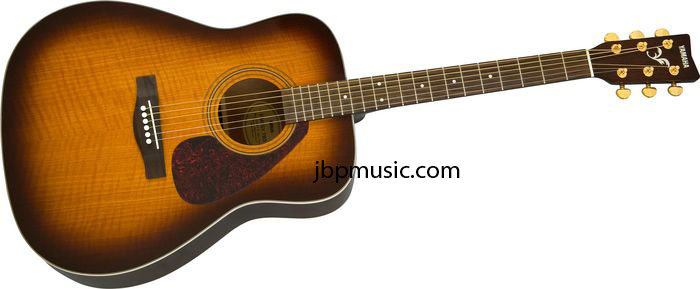 Quick Opinion:
Quick Opinion: The Yamaha F line of acoustic guitars is affordable, seriously consistent in their build quality, and generally a good choice when purchasing a budget all-around acoustic.
The F345, in particular, is exceptionally warm-sounding, and is extremely well-built. The sycamore top offers an interesting sound that is similar to mahogany, but with just a touch more depth. The appointments and features are very good. Overall, the F345 is definitely a keeper.
You can get more information and purchasing info about the Yamaha F345 here at Musician’s Friend.
 Playability:
Playability: The F345 is extremely playable and has a nice balance between comfort for smaller hands and playability for fingerstyle players. Although this is not a true finger-style instrument, a decent amount of room is left over (particularly near the bridge) for those who want to hybrid-pick. It is sized at an average in many respects when it comes to dimensions and build shapes.
For a dreadnaught guitar, smaller players will still find the F345 to be a big guitar. But, as dreadnaughts go, the neck and its attributes help bridge the gap very nicely. The size is just perfect for medium-to-large guitar players, and is still comfortable for those who have big paws.
The neck is really very nice. The finish is smooth and quick, and the shape is excellent. The F345’s neck feels like a graduated soft-V-to-C shape. It has a subtle V near the nut and smoothes down to an excellent C near the body. Of many acoustics I played while looking for the right one, this one had the best neck by far.
The frets are just right for this type of acoustic. They’re not too big, but they’re not the cheap, thin variety placed on many low-cost instruments. The ends are reasonably well-dressed (just a little jaggy here and there), and the string height is quite nice. My only grumbles are that there were a few too many frets that like to buzz. Given the excellent and consistent build quality of this instrument, I thought the frets could have been leveled better.
I generally play phosphor-bronze light strings (11s or so) with this type of instrument. Although I don’t have a gauge, I think this instrument came with 12s – and were 80/20 bronze. If you’re comfortable with more string effort, or don’t do much bending, the factory strings are very reasonable. For those with some difficulty playing harder strings, a quick change to 11s would do very well.
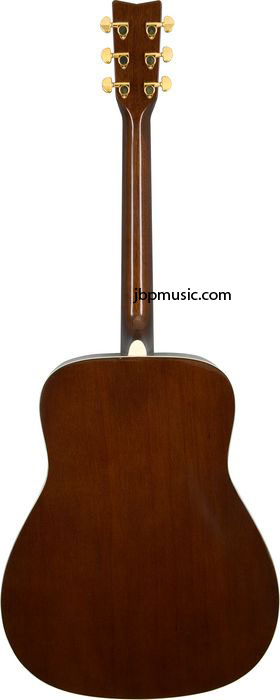 Features:
Features: The Yamaha F345 has elegant but simple binding on the front and back of the body. The finish is very nice, and is reminiscent of classic finishes from the 50s. It’s not the hard, plastic feel of many acoustics, it’s smooth and feels like a finish on an actual piece of wood. I don’t know what the finish is, but it is a nice, comfortable gloss.
The tuners are really quite nice on the F series instruments, and the F345 is no exception. The tuners strongly resemble and feel like Grover Rotomatics. They have a smooth action, and are very good at keeping the strings in tune. The tuners feel like they’re about 14:1 ratio – tuning up or down is easy and fine.
The wood for the F345 is laminate, but is extraordinarily well-done. The look, the feel, and the sound are well above par for a laminate-build instrument.
In general, the nut is reasonably well-cut and shaped, the bridge is strong (but not a compensated bridge). The rosette is nice and the pickguard is a wonderful, vintage-looking tortoise color. The saddle is a nice rosewood saddle, with well-cut peg holes (many guitars in this price range have terrible peg holes).
Sound: Another place the F345 shines is its sound. It is very warm in the lows, and mellow in the highs. It lacks the shrill high notes that many basic guitars have. In general, it is a nice middle-sound instrument for playing and even for some recording duties.
I’ve found the sycamore wood top to sound slightly warmer than mahogany, but not as dark as cedar. It is definitely growlier and brassier than a spruce top. It’s unusual – but unusual in a way that is very pleasant.
The sound in the upper registers of the strings is above average. The intonation is very close, even in the 12th fret through the 15th fret section of the neck. I find that I don’t have to compensate for intonation very often when playing this instrument.
The sound is reasonably loud – although it is not as loud as a spruce-top guitar. It has enough projection for medium to small spaces and applications. I would recommend amplification for bigger sound areas or for playing in a big group/band.
Value: The F345’s value is very good. It is definitely worth $250 as a street price. You get good sound, reliability, and consistent quality of build in an instrument that is quite attractive.
This particular bargain instrument is worth a decent hard shell case!
Wishes: I don’t have too many wishes for this instrument. It would look nicer with a split binding on the back and binding on the neck. I found some nice faux-tortoise tuner buttons that I’ve installed to give the guitar some nice additional class – the tuner buttons I purchased were built for Grover full-size Rotomatics, and fit like they were made for the Yamaha tuners.
The one wish that I would love to have in this acoustic (as well as other low-cost acoustics) is an adjustable-height bridge – like those in many Alvarez acoustics. Shimming is fine, but the ease of adjustables is hard to argue against.
Labels: acoustic guitar, F 345, F345, instrument, sycamore, yamaha, yamaha guitar
Ibanez SZ520QM SZ520 Electric Guitar Review
Ibanez SZ520QM Electric Guitar Review
When I was first looking for an electric guitar that I could use as a recording guitar and as a way for my son to cut his guitar-chops, I searched high and wide. I had a severely limited budget at the time I began playing again… and had to get some of the features I knew that I liked in a guitar from my early days.
I wanted a guitar that was tough enough to handle hard rock guitar but that didn't fold on me over time. I also wanted an instrument with lots of sustain, plenty of output, and a nice neck.
I ended up settling on an Ibanez SZ520 for a number of reasons. For sure, though, the SZ520 is a remarkable instrument – one that is not given its true kudos in the world of guitars. It is an unsung hero and an excellent instrument.
Quick Opinion: The Ibanez SZ line of electric guitars (and, to an extent, the Ibanez S line of guitars) are excellent instruments. They have the quick feel of a rocker’s guitar, fairly good quality, and excellent features.
These guitars have excellent playability, great sound, and a price that puts them at the mid range between less-expensive set-necks, and inexpensive top-brands. SZs are not a bargain – rather, they are at the top of their range. Whether or not to purchase an SZ will depend very highly on your personal feature interests, and your particular desire for a given sound. Let’s take a look at this fine instrument – with some comparisons along the way.
The SZ is no longer produced as a new product by Ibanez, but you can see more about Free Shipping on Ibanez electrics at GuitarCenter.com
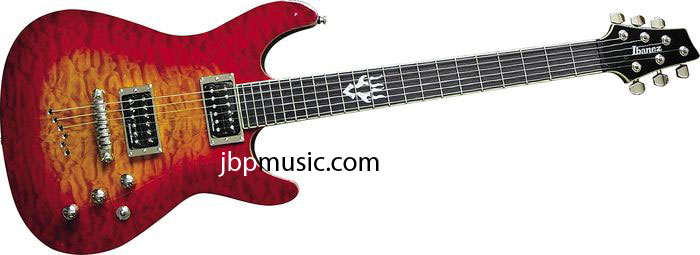 Ibanez SZ520QM Electric Guitar Review
Playability:
Ibanez SZ520QM Electric Guitar Review
Playability: Several things strike you immediately when you first pick up and play the SZ520. The neck is a dream – and lacks a big heel. The staggered, string-through design rings with sustain. The body is very nicely balanced and is of medium weight. The fretboard is comfortable.
The neck on the SZ520 is nearly ideal for chord players, shredders, and slide playing. It strikes a nice, medium-width balance against just a deep-enough “C” shape to get a grip on it when you’re running up and down the neck. The neck back is painted to match the body, and has a nice, hard, smooth finish. The neck-to-body join is superb on this instrument – few electrics get anywhere close to this nice of a join. The heel-less feels fantastic when you’re flitting around above the 14th fret. I truly wish most Gibsons and Epis had this type of neck join on their electric guitars.
The body balance is above average, if not pretty close to excellent. After playing the SZ for several hours, you don’t feel like you’re struggling with an unruly animal. It just feels good where it is – especially since the weight is medium in the spectrum. A Fender Stratocaster is significantly lighter in
feel, and a Les Paul is a bit heavier in
feel.
The fretboard, string-spacing, and fret size are an interesting combination – almost unique when compared to the other manufacturer’s view on fretboards. The fretboard is subtly different from most any other instrument out there. For those who are familiar with Fenders: it is thinner than a Strat and wider than a Tele – very similar to the superb and underrated Fender TC-90. For you Gibson and Epi fans out there, the SZ is much more like an Epiphone SG with respect to its neck. The fretboard is extremely similar to the Epi G400s I’ve played.
Fingerstyle players or players who use a modified pick hand (like myself) will find the strings a bit close together. However, this is balanced out by overall comfort, and the ease of gripping chords.
In order to get great sounds out of the SZ in slide and chord/soloing, the strings had to be at least 10s with thicker middle strings (and better, 11s or 12s). Custom light and extra-light strings sound muddy and don’t tune well when applied to the SZ. Also, the tone and sustain are robbed with smaller-gauge strings. I tried 10s Fenders, several 10s GHSs, and even the venerable D’Addario XL110s on the SZ, and none of them sounded very good. I ended up settling between D’Addario XLs with a minimum 11 high E-string and Ernie Ball Power Slinky (11.14.18.28.38.48). The Ernie Ball Power Slinky strings sounded the best by far.
If you’re not going to slide on the SZ, you’ll still need to get some good calluses and stay with a set that is 11 and above. 12s were just too thick for me on this instrument – I had a hard time getting a good vibrato and smooth-transition string-bends with 12s.
The fretwork of the SZ I owned was superb in almost any respect. The frets are medium in overall size and height, and the ends were reasonably well-dressed. The nut was well-worked and had no issues at all.
Features: The Ibanez SZ520QM (QM stands for “quilted maple” cap) is a high-feature guitar made in Korea. It has a gorgeous quilted maple cap on a warm and medium-thick mahogany body. The tuners are OK (not great), but the neck inlay is beautiful (my guitar got the name “blue flame” because of its 12th fret inlay). The finish on the guitar is deep and lustrous.
The heel-less neck feature is worth mentioning again. Feel it for yourself – most folks will absolutely love it.
The binding is light-cream, and is superbly done. I only felt the “edge” of the binding in one or two places on the front of the body, and none on the neck.
The Duncan/Ibanez open-face humbuckers are a nice feature. They strike a nice balance between being able to play stronger, more assertive music – and music that is marginally mellower.
The string-end design is string through. The staggered string holes are of varied lengths from the bridge and its saddles. Unlike many string-throughs, there is no tailpiece – the strings feed directly from the bridge to the holes in the body.
The Gibralter III bridge makes intonation a fairly easy task, and is completely buzz-free. It is stud-mounted to the top of the guitar, so lots of sound emanates through the bridge very nicely into the guitar body.
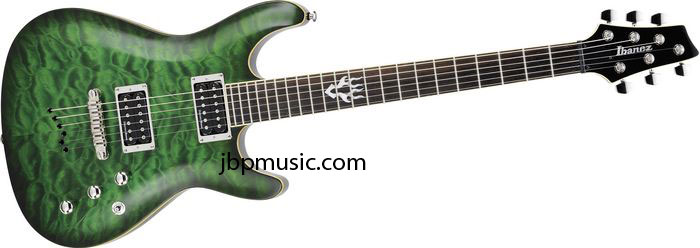 Sound:
Sound: The SZ520QM sounds wonderful. It has tons of sustain (although an Epi or Gibson Les Paul still have a longer and warmer sustain – the SZ is more like a set-neck SG in sound and sustain). The pickups and electronics are clean and noise-free. Sonically, the SZ is a good crossover guitar – from harder music to classic rock.
I found the pickups to be not as high on the output scale (sound-wise – I didn’t pull them and put them on a multi-meter) as you get with EMGs or more aggressive Seymour Duncan humbuckers. They are louder than my first Epiphone Les Paul’s original open-face humbuckers, but they are not as rich and creamy.
The pickup-selection-and-tone part of the guitar is pretty good. The SZ has the often-used Tone-Volume-Volume plus pickup switch hardware setup. With the SZ520QM, there is one master tone knob, the middle knob controls the bridge pickup volume, and the knob closest to the neck controls the volume of the neck pickup. The SZ also uses a fairly standard (but extremely well-made) pickup selector toggle switch.
Value: Value for the money is where the SZ is not quite a clear winner. I don’t think the guitar is terribly over-priced, but it is not a bargain in any sense. The Fender TC-90 (albeit with Black Dove P90 pickups) and the Epiphone Explorer and Epiphone Flying V are much better performers – yet they all cost less. A similarly-equipped Dean, Jackson, or Schecter is generally a better bargain for sound and price.
With that said, and in all fairness, the SZ520 does have a great feel, and does a decent enough job for the sound. I am a fan of Ibanez guitars, and there are many models that are great… I just think the SZ 520 should be a little lower in price. – or should have higher-end Seymour Duncans to bring up the value.
Wishes: Some nickel-covered and upgraded Seymour Duncans would be great (or, even better, some EMG HZ passive pickups, perhaps H4s). I really think Ibanez should choose to use some nice Grovers as tuners, or at least some locking tuner/locking nut offerings on this guitar.
Labels: acoustic guitar, bear, electric guitar, ibanez, review, set neck, shredder, sz, sz520, sz520QM
Ibanez ArtWood AW 40 Acoustic Guitar Review
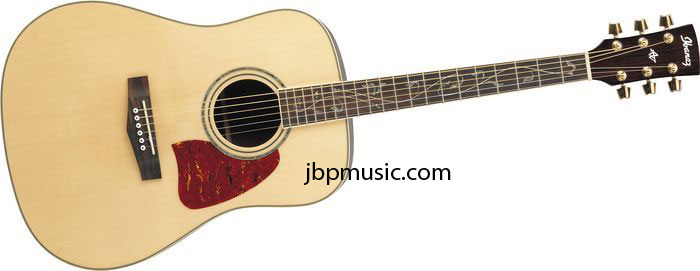
Update, October 2009 Sigh... the AW40 is no longer in production. I've since found a used one that had been dropped and have rehabilitated it into my mountain-trips guitar. Lovely, wonderful, plays well, sounds awesome, even after it was dropped (hard) by its previous owner.
I had been looking for an affordable solid-spruce-top 6-string acoustic for nearly a year. I was looking for medium-bright sound that also had crisp, clean basses, but with good resonance, easy playability, and good intonation. Finding a guitar that meets these expectations, and is under $400, is a real challenge.
I started my quest by playing countless acoustics at both my local guitar stores. I probably played more than 200 different low-cost acoustics – specifically looking for my target attributes.
I eventually discovered the Ibanez AW 40. This delightful acoustic guitar is from Ibanez's ™ ArtWood™ series acoustics. The street price for the AW 40, both locally and on the street was $200US. This new AW 40 turned out to be the guitar I purchased – and I’m very glad I did. I bought the AW 40 (mine is named “Rosie”) from my Sam Ash guy and have played it quite a bit – it has been used on many songs across three different acoustic albums of mine.
Quick Opinion: I chose to play the AW 40 on and off for a few weeks before I actually purchased it. I wanted to play several other contenders in comparison just to be sure:
The AW 40 is a bargain, and is an excellent purchase! It has excellent craftsmanship, good features, and sounds like guitars that cost $200-$300 more. Purchasers of the AW 40 are VERY unlikely to be disappointed! This is the second-most-played-acoustic I own.
Free Shipping and more information about Ibanez Artwood acoustics here at GuitarCenter.com Playability:
Playability: The neck is a delightful satin-finish soft “c”-ish shape (the rosewood color is unique, too). This guitar plays nicer than the gloss-finish necks of many other guitars in this price range.
The frets are finished nicely, and are just the right balance of height and thickness. The scale is just right – medium. There are no buzzy frets on the example I purchased. The string height was a little too low when I brought it home, so I had to change the truss rod just a tad to stop general string buzz. Once I raised the strings a bit, the string sound was flawless.
The weight and depth of the AW 40 body is excellent, and the fretboard feels smooth and quick. The 1 5/8” width nut is just about right for this particular neck.
The AW 40 ships with
D’Addario EXP bronze strings (opens new window), starting with .11 width on the 1st string. These particular strings are really quite nice (especially if you like coated strings), and are appropriate if you like a little darker high sound. After a week or so with the stock strings, I switched to D’Addario EXP phosphor-bronze .11s to give me the crisper bass sounds I was seeking. Once the new strings were installed, this guitar has been giving the low-end
Martin™ guitars (opens new window) a strong run for the money.
Sound: Crisp, crisp, crisp, resonant, and more crisp! The solid spruce top lives up to its job very well. The bass sounds are clean and clear. The 1st and 2nd strings above the 13th fret are a little thin for my tastes. The midranges are clean and rarely muddy for finger-picked notes. The body resonates nicely against your chest and hands when the guitar is played. Very nice!
Value: This is a $450 guitar in value (not 'retail',
'street'). The sound, quality of make, and appointments are top-notch, excellent. To get a better instrument, you’d have to spend at least $499. This guitar is made in China, but you would have difficulty telling its origin from the excellent build quality.
Features: This is an excellently-designed instrument. It has the bits needed for daily use and for recording alike. The body is fully bound in a nice white-with-black stripes motif. The rosette is a beautiful abalone-ringed decoration. The headstock has inlaid pearl Ibanez logo and AW logo. The back of the guitar has a nice black-white center stripe and nicely matched halves. The red-ish shell pickguard does seem a bit bright for the cream-colored spruce top, but is pleasant enough.

An unexpected and
BEAUTIFUL feature of the AW 40 is the
abalone "vine of life" fretboard inlay. This is truly a nice-looking addition, and is really nice and unique. I always get good comments on this feature every time folks see Rosie.
The stock tuners are mechanically sound, but felt a bit uncomfortable. In addition, the gold plating on the tuners was not well done at all. It looked as though the gold had barely been applied (this was true on all the examples I played).
More about the tuners: I ended up replacing the stock machine heads/tuners with Grover™ Rotomatic™-style 14:1 tuners. The screw holes did not match the factory screw placements exactly, but I felt it was worth it to drill new screw holes and putty the old ones – and gain excellent tuners. I bought chrome Grovers, and they look very nice with the rest of the guitar’s appointments. The Grovers function flawlessly and are, well, they're Grovers ('nuff said!).
Wishes: The tuners really should have been better-made and better executed. Even the Yamaha™ basic guitar tuners work better and look better than those on the AW line.
Labels: acoustic guitar, art wood, artwood, aw 40, aw40, guitar, ibanez, instrument





















